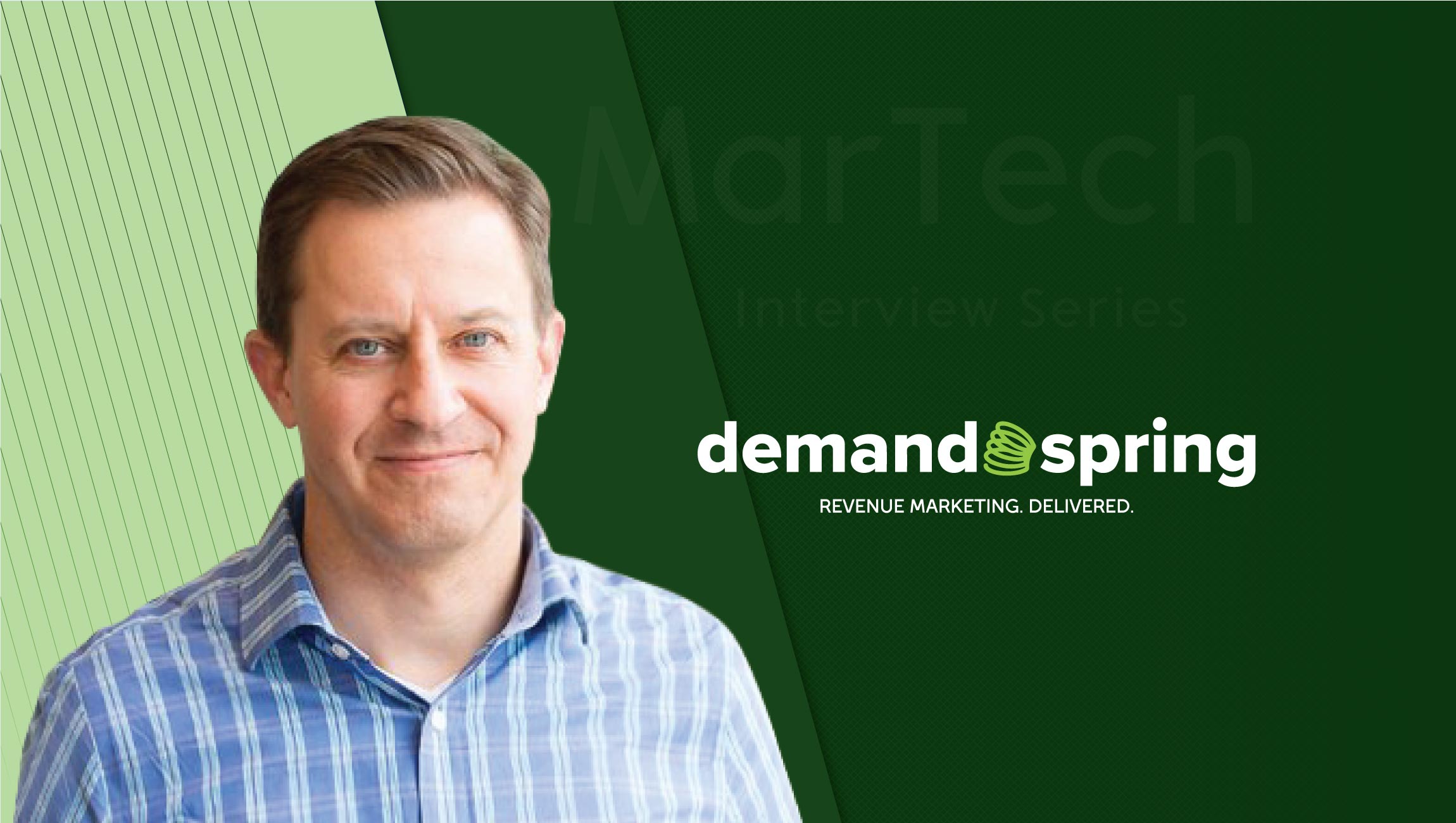“As a business leader, I think it’s critical that you continue to assess how you leverage the mix of assets available to you to drive performance.”
[/vc_wp_text][easy-profiles profile_twitter=”https://twitter.com/mark_dspring?lang=en” profile_linkedin=”https://www.linkedin.com/in/markemond1/”]
Journey into Tech
Hi Mark, tell us about your journey into Revenue Marketing? What inspired you to be part of a Marketing Technology company?
A big gap in the market inspired me to start Demand Spring. We are a Revenue Marketing consultancy. We help B2B marketers optimize their practices for building pipeline and contributing to revenue. I was a marketing leader on the client-side in the technology industry for 16 years prior to founding Demand Spring. I worked with some great agencies, some of the biggest in the world, but I always found that their best and brightest were focused on building brand, not driving demand. I felt like if I could create a great demand-focused agency with really experienced people that we could help marketers like myself.
You have led Marketing and Demand-Gen teams for some of the most renowned SaaS companies. How much have Marketing technologies evolved since you first started in the industry?
So I started my career before the Industrial Revolution (half-kidding). I actually started in the technology industry in 1996. The Internet was new, CRM was very heavy, and there was no such thing as Marketing Automation. For B2B Marketers, life really changed with Marketing Automation. When I was at Cognos, we were Eloqua’s biggest client and Salesforce’s first $1M client. We were doing amazing things for 2007 — we had 1,400 inbound nurture streams and knew the exact golden path of behavior for optimal conversion for our target personas. MarTech has come so far since then. It’s amazing to see not just the growth of the technology, but the common Revenue Marketing practices and culture that has developed around it. The result is that marketing can now deliver the type of relevant, hyper-targeted engagement that enables us to be a primary source of education throughout the entire buyer journey. This is a sea change for B2B marketers, whose job when I started was to keep the food warm and the beer cold.
Demand Spring Insights
Can you define Revenue Marketing in less than 10 words!!!
Marketing that drives consistent pipeline and revenue contribution.
You service to some of the leading global technology companies. What does your ideal customer profile look like? Which other companies can also benefit from your Revenue Marketing tools and solutions?
Our team gets excited about working with organizations who are serious about transforming their marketing practices. We do B2B work almost exclusively, with deep expertise in the technology and financial services industries. Our clients tend to be really fast-growing start-ups who are deep enough in their financing to invest in people and technologies, mid-market organizations, and we do a lot of work in Fortune 1000 organizations.
Which Marketing, Sales and Communication tools do you use at Demand Spring?
From Day 1, I wanted to build a scalable technology infrastructure that we wouldn’t outgrow every two years. We use Salesforce as our CRM, Marketo for Marketing Automation, Zoom (we are highly virtual, so we love this platform), Slack, WordPress as our CMS, Drift, G-Suite, MavenLink for project management, ZoomInfo and Linkedin Sales Navigator for data discovery, and Proposify for proposal management.
Which tools and platforms did you really miss having in the initial part of your career?
All of the above! Especially video conferencing – it makes such a difference for connecting and engaging with team members, customers, partners, and our board.
Marketing Sales Alignment
What are your thoughts on the blurring boundaries in Marketing, Sales and Customer Support?
It’s a situation where the customer is in control of the client journey today and they are interacting with all three teams in an interdependent manner. So, for organizations to deliver a great customer experience these organizations need to be working together in a really collaborative way. The Marketing and Sales relationship has come a long way in many organizations in the past 5 years. Collaboration between Marketing and Customer Support is still sparse at best in many companies.
Tell us more about your alignment with the Sales and Product development teams? As a business leader, how do you ensure that your Sales and Customer Service departments are able to solve unique challenges for customers?
As a consultancy, our Practice leaders are responsible for their P&L, which includes driving revenue for their services. So, they are really tightly aligned and very customer-centric.
What kind of coordination do you maintain with your CEO, CMO, CIO and CTO? What are the usual points of disagreements in these functions?
We have tight alignment and communication across our leadership team. How to effectively manage growth and when and where to invest in growth opportunities are the conversations that sometimes require additional attention in our organization.
We’re seeing a rampant adoption of AI, Blockchain, and RPA in the revenue marketing businesses. What approach do you take in digitally transforming your operations with AI ML and RPA techniques? Have they borne you satisfactory results?
We are in pilot mode with AI in both our own business (e.g., the use of Drift for conversational marketing on our website) and with clients with technologies like 6Sense, Drift, and Conversica. We see how AI and RPA will augment or replace some human activity around repetitive tasks in marketing and sales but we also believe that the humans of marketing will long be the most critical assets within the marketing organization.
What are your predictions for Revenue Marketing tools in the Americas, and APAC + ANZ markets for 2020-2024?
We see consolidation of vendors, especially since there is a good likelihood of economic contraction happening in this timeframe. We also see tremendous growth in capabilities. Take marketing automation for example. Today, humans decide the right time, day, message, and channel to send to each individual. We think those tasks are better suited to AI and machine learning. We see a broadening of platforms with the acquisitions that are happening. Take Salesforce and Adobe for example. Salesforce has two MAP platforms, and recently purchased both Tableau and Evergage. We think over time these capabilities will be part of one seamless platform. Likewise for Adobe with capabilities being seamlessly integrated from today’s individual “products” such as Marketo, Adobe Target, Adobe Audience Manager, etc.
How do you prepare for an AI-centric world as a Business Leader?
For us, it all starts with strategy and the customer. That’s why we have built our team with a mix of strategists, content marketers, and technologists. AI is simply a means of executing a customer-centric strategy. In many cases it will create efficiencies and better performance, but only if you apply it to the right customer-centric strategies. As a business leader, I think it’s critical that you continue to assess how you leverage the mix of assets available to you to drive performance — between full-time permanent workers, outside flex workers, and AI capabilities to automate repetitive tasks.
This Is How I Work
How do you inspire your people to work with technology?
For us, as a largely virtual organization it’s a means of connecting and engaging with one another and our customers and partners. We try to give our team the best technology possible to deliver on our founding principles of being a great place to work and a great place to do business with. We never want the technology to be a barrier to helping marketers stand taller.
One word that best describes how you work.
Persistent.
One superhero character that you idolize or profoundly connect with in your life and at work –
The dad in the Incredibles – just trying to do his job, take care of his family, and catch his breath!
What startups in the technology industry are you watching keenly right now?
One of our partners, Voicify. They are doing some really great things to scale voice-enabled content. Also UpEffect which crowdfunds capital for entrepreneurs building companies for social good. At this stage of my life I am much more interested in those types of companies over ones that create tremendous wealth for a handful of people.
Something you do better than others – the secret of your success?
Creating a culture that places the importance of people and the communities we work in ahead of financials.
Tag the one person in the industry whose answers to these questions you would love to read.
I will give you three — Ann Handley, Jay Baer, and Seth Godin. Ann and Jay are so plugged in and they make me laugh. Seth is so brilliant that I would love his perspective on these topics.
Thank you, Mark! That was fun and hope to see you back on MarTech Series soon.
Mark is founder and President at Demand Spring, an organization of dynamic, experienced individuals with a passion for working with B2B Marketers in building the marketing strategies, content, and technology stacks that drive transformation and top-line results.
Pipeline is oxygen for your business. Demand Spring helps B2B organizations breathe easier. We are a demand generation consultancy that will help you:
- Optimize pipeline creation and progression
- Enhance marketing automation strategies
- Develop marketing analytics strategies
- Conduct customer buying cycle and persona analysis
Drive lead management between sales and marketing Our experience is on the client-side, so we understand your challenges.












